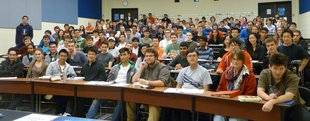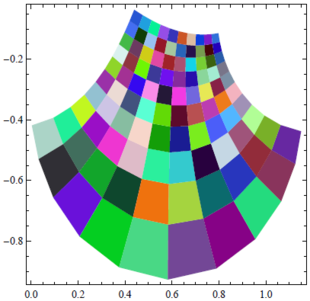12-240/Classnotes for Tuesday September 11: Difference between revisions
No edit summary |
No edit summary |
||
| Line 1: | Line 1: | ||
{{12-240/Navigation}} |
{{12-240/Navigation}} |
||
In this course, we will be focusing on both a practical side and a theoretical side. |
|||
== Practical Side == |
|||
1. |
|||
Solving complicated systems of equations, such as: |
|||
:<math> 5x_1 - 2x_2 + x_3 = 9\!</math> |
|||
:<math>x_1 + x_2 - x_3 = -2\!</math> |
|||
:<math>2x_1 + 9x_2 - 3x_3 = -4\!</math> |
|||
2. |
|||
We can turn the above into a matrix! |
|||
:<math> |
|||
\begin{pmatrix} |
|||
5 & -2 & 1 \\ |
|||
-1 & 1 & -1 \\ |
|||
2 & 9 & -3 |
|||
\end{pmatrix} = A |
|||
</math> |
|||
== Theory Side == |
|||
3. |
|||
"The world doesn't come with coordinates." |
|||
We will learn to do all of this in a coordinate-free way. |
|||
4. |
|||
We'll learn to do all of this over other sets of numbers and fields. |
|||
== Hidden Agenda == |
|||
5. |
|||
We'll learn the process of pure mathematics by doing it. |
|||
We'll learn about: |
|||
*Abstraction |
|||
*Generalization |
|||
*Definitions |
|||
*Theorems |
|||
*Proofs |
|||
*Notation |
|||
*Logic |
|||
---- |
|||
A number system has specific properties of the real numbers. |
|||
== Real Numbers == |
|||
A set, <math>\mathbb{R}\!</math>, with: |
|||
*Two binary operations, addition and multiplication. |
|||
*Two special elements, 0 and 1. |
|||
The real numbers have some special properties: |
|||
=== Commutative Laws === |
|||
<math>\mathbb{R}1</math> |
|||
:<math>\forall\ a, b\ \epsilon\ \mathbb{R} \quad a+b = b+a\!</math> |
|||
:<math>\forall\ a, b\ \epsilon\ \mathbb{R} \quad ab = ba\!</math> |
|||
=== Associative Laws === |
|||
<math>\mathbb{R}2</math> |
|||
:<math>\forall\ a, b, c\ \epsilon\ \mathbb{R} \quad (a + b) + c = a + (b + c)\!</math> |
|||
:<math>\forall\ a, b, c\ \epsilon\ \mathbb{R} \quad (ab) \cdot c = a \cdot (bc)\!</math> |
|||
=== Existence of "Units" === |
|||
<math>\mathbb{R}3</math> |
|||
:<math>\forall\ a\ \epsilon\ \mathbb{R} \quad a + 0 = a\!</math> |
|||
:<math>\forall\ a\ \epsilon\ \mathbb{R} \quad a \cdot 1 = a\!</math> |
|||
=== Existence of Negatives/Inverses === |
|||
<math>\mathbb{R}4</math> |
|||
:<math>\forall\ a\ \epsilon\ \mathbb{R}\ \exists\ b\ \epsilon\ \mathbb{R} \quad a + b = 0\!</math> |
|||
:<math>\forall\ a\ \epsilon\ \mathbb{R}\ \exists\ b\ \epsilon\ \mathbb{R} \quad a \cdot b = 1\!</math> |
|||
=== Distributive Law === |
|||
<math>\mathbb{R}5</math> |
|||
:<math>\forall\ a, b, c\ \epsilon\ \mathbb{R} \quad (a+b) \cdot c = ac + bc\!</math> |
|||
==== An example of a property that follows from the earlier ones: ==== |
|||
:<math>a^2 - b^2 = (a + b)(a - b)\!</math> |
|||
We can define subtraction and squaring from the properties covered above. |
|||
==== An example of a property that does not follow from the earlier ones: ==== |
|||
The existence of square roots: |
|||
:<math>\forall\ a\ \exists\ b\ \quad b^2 = a\ or\ b^2 = -a\!</math> |
|||
We can construct a set that has all of the 5 properties described above, but for which this property does not follow. |
|||
This set is the rational numbers. |
|||
There is a rational number <math>a\!</math> where there is no <math>b</math> in the set. |
|||
This is because<math>\sqrt{2}</math> is irrational. |
|||
== Fields == |
|||
The properties we have been discussing aren't restricted to only the real numbers. |
|||
They are also properties of: |
|||
*Rational numbers |
|||
*Complex numbers |
|||
*Others |
|||
Let's construct an abstract universe where these properties hold. |
|||
Definition: Field |
|||
*A field is a set, <math>\mathbb{F}</math>, with: |
|||
**Two binary operations, addition and multiplication. |
|||
**Two special elements, 0 and 1, where 0 does not equal 1. |
|||
**All of the above mentioned properties hold. |
|||
Now, instead of speaking of <math>\mathbb{R}1,\ \mathbb{R}2,\ \mathbb{R}3,\ \mathbb{R}4,\ \mathbb{R}5</math>, we can speak of <math>\mathbb{F}1,\ \mathbb{F}2,\ \mathbb{F}3,\ \mathbb{F}4,\ \mathbb{F}5</math>. |
|||
We have abstracted! |
|||
== Examples of Fields == |
|||
*Take <math>\mathbb{F} = \mathbb{R}</math> |
|||
*Take <math>\mathbb{F} = \mathbb{Q}</math> (Rational numbers) |
|||
*The complex numbers. <math>\mathbb{C} = \lbrace a + bi \quad a, b\ \epsilon\ \mathbb{R} \rbrace</math> |
|||
The above fields have an infinite number of elements. We can also have finite fields: |
|||
*<math>\mathbb{F} = \mathbb{F}_2 = \mathbb{Z}/2 = \lbrace 0, 1 \rbrace</math> |
|||
**There are only 2 elements. |
|||
**You can think of 0 as even and 1 as odd, which will help you construct the tables below. |
|||
**You can also think of the results below as the remainder of the operations when divided by 2. (mod 2) |
|||
::{| border="1" |
|||
! scope="col" | + |
|||
! scope="col" | 0 |
|||
! scope="col" | 1 |
|||
|- |
|||
! scope="row" | 0 |
|||
| 0 || 1 |
|||
|- |
|||
! scope="row" | 1 |
|||
| 1 |
|||
| 0 |
|||
|} |
|||
::{| border="1" |
|||
! scope="col" | x |
|||
! scope="col" | 0 |
|||
! scope="col" | 1 |
|||
|- |
|||
! scope="row" | 0 |
|||
| 0 || 0 |
|||
|- |
|||
! scope="row" | 1 |
|||
| 0 |
|||
| 1 |
|||
|} |
|||
*<math>\mathbb{F} = \mathbb{F}_3 = \mathbb{Z}/3 = \lbrace 0, 1, 2 \rbrace</math> |
|||
::{| border="1" |
|||
! scope="col" | + |
|||
! scope="col" | 0 |
|||
! scope="col" | 1 |
|||
! scope="col" | 2 |
|||
|- |
|||
! scope="row" | 0 |
|||
| 0 || 1 || 2 |
|||
|- |
|||
! scope="row" | 1 |
|||
| 1 |
|||
| 2 |
|||
| 0 |
|||
|- |
|||
! scope="row" | 2 |
|||
| 2 |
|||
| 0 |
|||
| 1 |
|||
|} |
|||
::{| border="1" |
|||
! scope="col" | x |
|||
! scope="col" | 0 |
|||
! scope="col" | 1 |
|||
! scope="col" | 2 |
|||
|- |
|||
! scope="row" | 0 |
|||
| 0 || 0 || 0 |
|||
|- |
|||
! scope="row" | 1 |
|||
| 0 |
|||
| 1 |
|||
| 2 |
|||
|- |
|||
! scope="row" | 2 |
|||
| 0 |
|||
| 2 |
|||
| 1 |
|||
|} |
|||
*<math>\mathbb{F} = \mathbb{F}_5 = \mathbb{Z}/5 = \lbrace 0, 1, 2, 3, 4 \rbrace</math> |
|||
**Not going to bother making the tables here. |
|||
*<math>\mathbb{F}_4</math> is '''not a field.''' |
|||
**It does not have the property <math>\mathbb{R}5</math>. |
|||
:::<math>2 \cdot 0 = 0</math> |
|||
:::<math>2 \cdot 1 = 2</math> |
|||
:::<math>2 \cdot 2 = 0</math> |
|||
:::<math>2 \cdot 3 = 2</math> |
|||
:::We never got a 1. |
|||
*If the subscript is a prime number, it is a field. |
|||
---- |
|||
Theorem: |
|||
1. |
|||
:Let F be a field. |
|||
:<math>\forall a, b, c\ \epsilon\ \mathbb{F} \quad a+b = c+b</math> |
|||
::"Cancellation Lemma" |
|||
:<math>\Rightarrow a = c</math> |
|||
2. |
|||
:<math>ab = cb, b \ne 0</math> |
|||
:<math>\Rightarrow a = c</math> |
|||
We'll cover 3-11 next class! |
|||
Proof of 1: |
|||
:Let <math>a, b, c\ \epsilon\ \mathbb{F}</math> |
|||
:by <math>\mathbb{F} 4\ \exists\ d\ \epsilon\ \mathbb{F} \quad b+d = 0</math> |
|||
:so with this d, <math>a+b = c+b\!</math> |
|||
:and so <math>(a+b)+d = (c+b)+d\!</math> |
|||
:so by <math>\mathbb{F} 2</math>, <math>a+(b+d) = c+(b+d)\!</math> |
|||
:so <math>a+0 = c+0\!</math> |
|||
:so by <math>\mathbb{F} 3 \quad a = c\!</math> |
|||
:<math>\Box</math> |
|||
Revision as of 21:32, 11 September 2012
| |||||||||||||||||||||||||||||||||||||||||||||||||||||||||
In this course, we will be focusing on both a practical side and a theoretical side.
Practical Side
1. Solving complicated systems of equations, such as:
2.
We can turn the above into a matrix!
Theory Side
3. "The world doesn't come with coordinates." We will learn to do all of this in a coordinate-free way.
4. We'll learn to do all of this over other sets of numbers and fields.
Hidden Agenda
5. We'll learn the process of pure mathematics by doing it. We'll learn about:
- Abstraction
- Generalization
- Definitions
- Theorems
- Proofs
- Notation
- Logic
A number system has specific properties of the real numbers.
Real Numbers
A set, , with:
- Two binary operations, addition and multiplication.
- Two special elements, 0 and 1.
The real numbers have some special properties:
Commutative Laws
Associative Laws
Existence of "Units"
Existence of Negatives/Inverses
Distributive Law
An example of a property that follows from the earlier ones:
We can define subtraction and squaring from the properties covered above.
An example of a property that does not follow from the earlier ones:
The existence of square roots:
We can construct a set that has all of the 5 properties described above, but for which this property does not follow.
This set is the rational numbers.
There is a rational number where there is no in the set.
This is because is irrational.
Fields
The properties we have been discussing aren't restricted to only the real numbers.
They are also properties of:
- Rational numbers
- Complex numbers
- Others
Let's construct an abstract universe where these properties hold.
Definition: Field
- A field is a set, , with:
- Two binary operations, addition and multiplication.
- Two special elements, 0 and 1, where 0 does not equal 1.
- All of the above mentioned properties hold.
Now, instead of speaking of , we can speak of .
We have abstracted!
Examples of Fields
- Take
- Take (Rational numbers)
- The complex numbers.
The above fields have an infinite number of elements. We can also have finite fields:
-
- There are only 2 elements.
- You can think of 0 as even and 1 as odd, which will help you construct the tables below.
- You can also think of the results below as the remainder of the operations when divided by 2. (mod 2)
+ 0 1 0 0 1 1 1 0
x 0 1 0 0 0 1 0 1
+ 0 1 2 0 0 1 2 1 1 2 0 2 2 0 1
x 0 1 2 0 0 0 0 1 0 1 2 2 0 2 1
-
- Not going to bother making the tables here.
- is not a field.
- It does not have the property .
- We never got a 1.
- If the subscript is a prime number, it is a field.
Theorem:
1.
- Let F be a field.
-
- "Cancellation Lemma"
2.
We'll cover 3-11 next class!
Proof of 1:
- Let
- by
- so with this d,
- and so
- so by ,
- so
- so by



















































